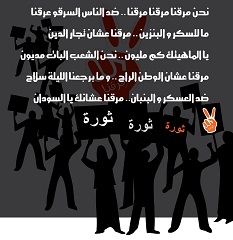What's Happening in Sudan?

Sudanese citizens have been demonstrating since June 18, following a series of brutal crackdowns of demonstrations against the announcement of a new round of austerity measures impacting food and fuel prices. Protests are not new to Sudan, with a faltering economy, continued conflict in Darfur and disputes with South Sudan fueling discontent. However, the recent demonstrations have evolved into a popular uprising, calling for freedom, peace, justice and liberty and the end of Bashir's rule.
Many observers believe that these recent protests are an indication that Sudan may be having its own Arab Spring movement. Sudanese activists Yousif Mubarak and Sara Elhassan reported on the blog Muftah:
Many have debated Sudan’s perceived reluctance to join the Arab Spring, particularly since the country’s situation has arguably been the most conducive to revolution. Many theories have been proposed and range from hopelessness and helplessness to disillusionment with the country’s weak opposition.In reality, the Sudanese people are resilient; continuous hardships and difficult experiences have given them the ability to endure, and their strong social fabric equips them to absorb more than most. As history has shown, when they decide that “enough is enough” then it overwhelmingly is; and it seems that decision has now been made.
Sudanese blogger Amir Ahmad elaborates in his FP op-ed on how the recent wave of demonstrations are different than those held previously:
They have been strategically dispersed -- relatively small crowds have spread out in numerous locations throughout Khartoum, stretching and exhausting the security forces' resources. Demonstrations calling for the fall of the regime erupted in university campuses as well as in Wad Nubawi, al-Sajjana, Bahri, Jabra, al-Kalaakla, and Um Badda, among other neighborhoods and areas in the capital.Unlike in the past, the protests were not just led by students but also by older folks, and Sudanese women and mothers. There were also coordinated protests in other towns and regions throughout Sudan such as Kosti, Sinnar, and the northern parts of the country.
Unsurprisingly, Bashir has claimed that "evil foreigners" are behind the demonstrations, and refers to protestors as "aliens and bubbles", on par with other repressive leaders in the region. As independent news outlets in Sudan are heavily censored, citizens have turned to social media for up to date informations. Civil society organizations like Girifna ("We are Fed Up") called for citizens to leverage the hastag #SudanRevolts on Twitter at 9 AM today to attract attention to protests in light of limited international media coverage of the demonstrations (excluding Al Jazeera), and other organizers continue to leverage Twitter and Facebook to share pictures and details of upcoming protests, expanding beyond Sudan and reaching supporters in Malaysia and the US.
Plans for mass rallies on June 30, the 24th anniversary of Bashir's National Congress Party in power, are underway. Like the demonstrations in Egypt and Tunisia, we at NDITech will keep a close eye on events as they develop.
